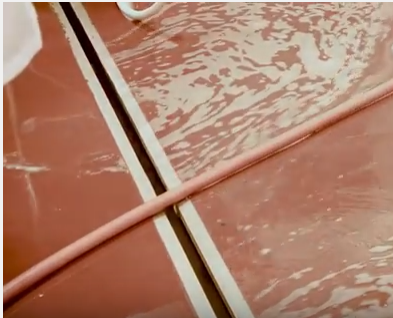Have you wondered how much liquid a Slot Drain® can handle, and how quickly it can drain? How does a Slot Drain® compare with other trench drain systems? We are often asked about the flow rate of a Slot Drain®. Slot Drain® has the ability to handle high-capacity drainage and has proven itself successful in hundreds of installations. Overall, the flow rate depends on the width of the slot opening.
Formulas to Calculate Slot Drain® Flow Rate
Unlike some other trench drain systems, it's fairly easy to figure out how much liquid a Slot Drain can handle. The width of the slot opening determines the flow rate. To calculate the flow rate of a Slot Drain, you can use these formulas:
- 1/2 inch slot opening = 11 gallons per minute per foot of slot
- 1 inch slot opening = 18 gallons per minute per foot of slot
- 1 1/4 inch slot opening = 27 gallons per minute per foot of slot
How do these formulas translate into real-world applications? Let's look at some comparisons.
To Put It Another Way...
Let's consider some liquid container sizes you might be familiar with.
- A bottle of water (16.9 oz) contains 0.13 gallons.
- A keg of beer holds 13.2 gallons.
- One fire truck water tank holds 1,000 gallons.
- An Olympic-sized swimming pool contains 660,430 gallons.
- The largest aquarium in the world, The Georgia Aquarium, is 10,000,000 gallons.
So, how long would it take a Slot Drain to carry away these volumes?
Let's consider a 9’ 8” section with a 1 1/4" slot width. This can drain away 260 gallons per minute.
So, our Slot Drain® could remove:
- 1,969.2 bottles of water in 1 minute.
- 19.7 kegs of beer in 1 minute.
- A fire truck full of water in 3.85 minutes.
- An Olympic-sized swimming pool in 42.34 hours.
- The largest aquarium in the world in 641.03 hours.
While we doubt you'll be sending all the water in the Georgia Aquarium down your drain, it can be done!
Other Considerations
While flow rate is an important consideration for trench drain systems, you'll also want to keep a few other things in mind.
- Depth: Slot Drain is available in a variety of depths to compliment flow requirements. You can obtain almost any flow rate you need by increasing the depth of the trough. On the other hand, if your project has shallow depth requirements, Slot Drain is an excellent choice, too. Our 7000 Series Slot Drain is great for landscaping applications with shallow depth requirements. If your project has shallow depth and low flow requirements, take a look at our 6000 Series Slot Drain system.
- Grates: For other trench drain systems, you have to carefully consider grate type, material, and size when calculating flow rate. One of Slot Drain's biggest advantages is that it eliminates grates. This makes it much more straightforward to select the system that meets your needs.
- ADA Compliance: If your slot drain system needs to meet ADA compliance standards, you'll want to choose a 1/2 inch slot. The .5" Slot Drain opening allows you to drain fluids at a high rate while still meeting safety and accessibility requirements.
- Clean in Place: If you work in hygiene critical industries (like food and beverage processing, dairy, brewing, pharmaceutical and cosmetics), you need to consider Clean in Place. Because Slot Drain® does not have gratings of any kind, Clean in Place is much easier than with other trench drain systems. If your facility requires frequent cleaning and sanitation, Slot Drain® is the cleanest choice.
- Weight Load Capacity: You'll want to calculate the heaviest load that will travel over your trench drain. Both our 9000 Series Slot Drain and our 7000 Series Slot Drain are heavy load class. Keep in mind that Slot Drain®eliminates grates entirely, which eliminates the main point of weakness in a drainage system.
Download a product guide for other technical specifications of Slot Drain®
Do you have questions about drainage? Need to know if Slot Drain® can work for your project's flow rate requirements? Contact us to talk to an expert. We can help you design the perfect system for your next project.



